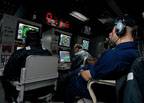Supreme Court Accepts Navy Sonar Requests
On June 23, 2008, the Supreme Court accepted a request by the Navy that the Court review a series of lower court rulings that restrict the Navy's use of sonar in training exercises off the coast of .
The original injunction, handed down in August 2007 by a U.S. District Court in and later amended, was affirmed by the Ninth Circuit Court of Appeals in February.
In March, the Navy requested the review that the Supreme Court has now accepted.
"My primary job is to ensure that Navy ships in the Pacific are prepared to fight and win in combat," said Vice Adm. Samuel J. Locklear, Commander, U.S. Third Fleet. "These restrictions make it very difficult to conduct the kind of realistic, integrated training exercises that ensure the combat effectiveness of our force."
The court-imposed mid-frequency active (MFA) sonar training restrictions include a requirement to shut down sonar altogether when marine mammals are within 2,200 yards of any sonar source and to reduce sonar power by 75 percent when the Navy detects significant surface ducting conditions, whether or not a marine mammal is present.
The 2,200-yard shutdown zone is eleven times greater than the existing shutdown distance that the Navy developed in consultation with the National Marine Fisheries Service.
The requirement to reduce sonar power by 75 percent during significant surface ducting conditions, whether or not a marine mammal is present, will prevent Navy strike groups from conducting training to detect submarines in the same conditions in which submarines seek to hide.
The Navy is trying to strike a balance between the need for an effective combat force and protecting the environment.
"We can protect our national security while simultaneously being good stewards of the environment," said the Honorable Donald C. Winter, Secretary of the Navy. "We are already taking extensive measures to protect marine mammals and we have had positive results from those measures. We are furthermore committed to an extensive data collection effort to help inform our future efforts in this regard."
When using MFA during major exercises or within established DoD ranges or operating areas, the Navy adheres to marine mammal protective measures approved by the National Marine Fisheries Service, the federal regulator responsible for marine mammal protection, issued under a National Defense Exemption in January 2007.
The Navy is also making a significant investment in the science, spending $26 million on marine mammal research this year.













